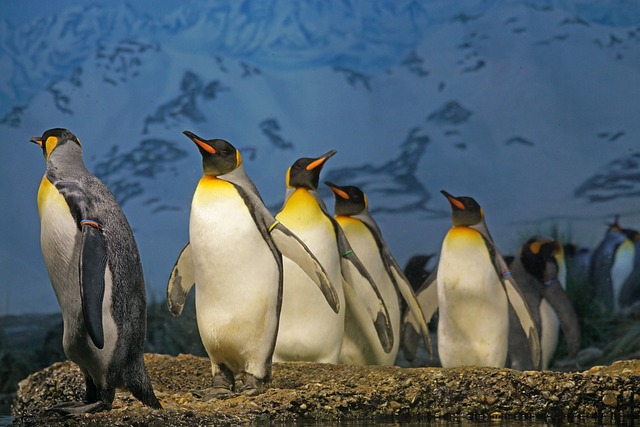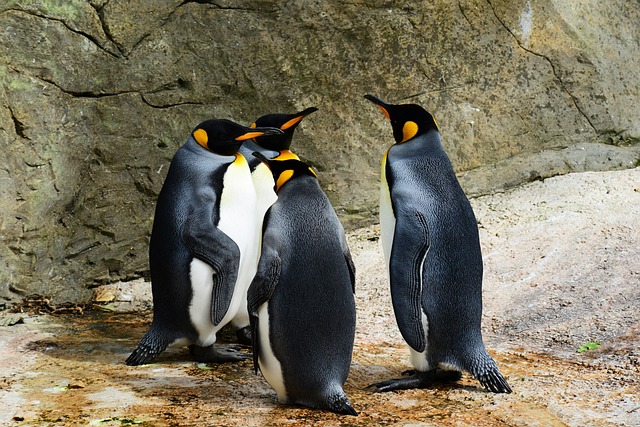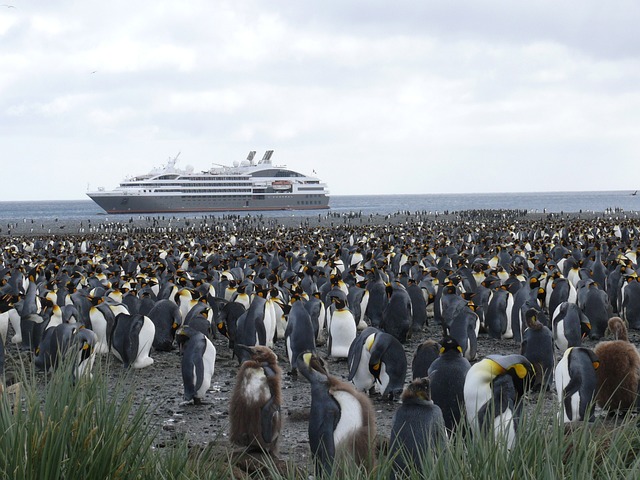In this article we look at 50 facts about King penguins
Scientific Name: The scientific name for the King penguin is Aptenodytes patagonicus.
Size: King penguins are the second-largest penguin species, standing about 28 to 35 inches (71 to 89 cm) tall.
Weight: They can weigh between 20 to 40 pounds (9 to 18 kilograms).
Plumage: King penguins have striking plumage with a bright orange-yellow patch on their throats, chests, and sides of their faces.
Habitat: They are primarily found on subantarctic islands, with the largest colonies on South Georgia, the Falkland Islands, and the Indian Ocean’s Crozet and Kerguelen Islands.
Range: King penguins have a circumpolar distribution, inhabiting the waters surrounding Antarctica.

Climate: They are well-adapted to cold and harsh subantarctic climates.
Feeding Habits: King penguins primarily feed on small fish and squid, which they catch while foraging at sea.
Diving Abilities: They are exceptional divers and can reach depths of up to 300 meters (985 feet) in search of food.
Speedy Swimmers: King penguins can swim at speeds of up to 10 miles per hour (16 kilometers per hour).
Communication: They communicate with each other through vocalizations, including trumpeting calls.
Colony Size: King penguin colonies can range from a few hundred to several hundred thousand individuals.
Colony Locations: These penguins often choose to nest on beaches or rocky shorelines.
Lifespan: In the wild, King penguins can live for around 15 to 20 years.
Breeding Season: They have a more extended breeding season compared to some other penguin species, typically starting in late November and lasting into April.
Egg Incubation: Both parents take turns incubating their single egg and keeping it warm.
Parental Care: After hatching, the chick is cared for by both parents, who alternate feeding and guarding duties.
Chick Development: King penguin chicks take about 11 months to fledge and become independent.
Molting: King penguins undergo an annual molt, during which they replace their old feathers with new ones.
Color Changes: During the molting process, their plumage appears duller and more grayish.
Swimming Adaptations: King penguins have strong flippers that help them swim efficiently.

Monogamous Pairs: They often form monogamous pairs and remain faithful to their mates during the breeding season.
Male and Female Differences: It’s challenging to distinguish males from females based on appearance alone; they both have similar plumage.
Predators: Natural predators of King penguins include large seabirds, seals, and orcas.
Distinctive Bill: They have long, slender bills adapted for catching and consuming fish.
Chicks’ Appearance: King penguin chicks have grayish-brown plumage, unlike the adults’ black and white coloring.
Communal Nesting: King penguins often nest in close proximity to one another, creating a communal nesting environment.
Vocalization Types: Their vocalizations include trumpeting calls and softer vocalizations used for communication within the colony.
Social Animals: King penguins are social birds and can often be seen in large groups both on land and at sea.
Flippers and Webbed Feet: Their flipper-like wings and webbed feet are essential for swimming.
Efficient Swimmers: They have a streamlined body shape that helps them glide effortlessly through the water.
Parental Care Duration: King penguins provide parental care to their chicks for several months.
Minimal Sexual Dimorphism: King penguins exhibit minimal sexual dimorphism, meaning males and females look very similar.
Steady Walkers: While on land, King penguins have a distinctive waddle as they walk upright.
Warmth in Numbers: Their close-packed colonies provide warmth and protection from the harsh subantarctic conditions.
Nocturnal Foraging: King penguins often forage at night, diving into the ocean to catch prey.
Stomach Storage: They have a specialized stomach for storing food, allowing them to consume larger quantities of fish and squid.

Unique Coloration: The bright orange-yellow patches on their throats are part of their distinctive coloration.
Courtship Displays: During the breeding season, they engage in courtship displays that involve head bobbing and mutual preening.
Vocal Repertoire: King penguins have a wide vocal repertoire, with each call serving specific purposes, from locating mates to chick recognition.
Large Colonies: Some of the largest King penguin colonies can contain over 200,000 individuals.
Dive Durations: King penguins can stay submerged for up to 5 minutes during dives.
Fish-Swallowing Technique: They often swallow fish whole, using their specialized stomachs to help digest prey.
Climate Adaptations: King penguins have adapted to the cold by developing a layer of insulating blubber.
Estimation of Colony Size: Researchers often estimate the size of King penguin colonies using aerial surveys.
Population Monitoring: Conservationists closely monitor King penguin populations to assess their health and the impact of environmental changes.
Conservation Initiatives: Efforts are in place to protect the subantarctic islands and waters where King penguins live.
Subspecies: There are two recognized subspecies of King penguins: Aptenodytes patagonicus patagonicus and Aptenodytes patagonicus halli.
Feather Maintenance: Regular preening and feather maintenance are essential for keeping their plumage waterproof.
Iconic Species: King penguins are one of the iconic and charismatic species of the subantarctic, attracting wildlife enthusiasts and researchers alike.
King penguins are remarkable birds, well-suited to the challenging conditions of their subantarctic habitat. They are known for their distinctive appearance and complex social behaviors, making them a subject of fascination for scientists and nature lovers around the world.
